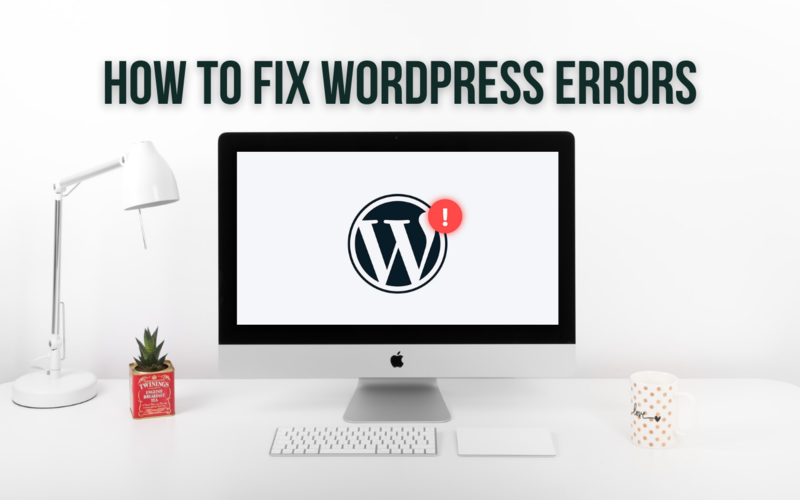WordPress is highly popular for its ease of access. However, with that ease comes with a price, with WordPress being prone to multiple major and minor errors. The DNS probe finished nxdomain is one common example of such errors.
While these errors are frustrating enough to ruin your day but the real problem arrives when you don’t know to resolve them.
Luckily for you, WordPress is a well-organized platform and the errors are usually a result of smaller root problems. If you know the source of these errors, you can quickly troubleshoot them by minor tweaking.
To help you resolve some of the regular WordPress issues, here’s a list of some common WordPress errors and methods to troubleshoot them.
Let’s begin.
1. WSoD (White Screen of Death) Error
First on our list is the WSoD (White Screen of Death) error. It is one of the most common, yet most annoying errors on WordPress because all you get here is a blank screen with no error code or information whatsoever.
Simply said, if you’re facing this error for the first time, you’ll get 0 assistance from the website itself.
Now there are multiple reasons for WSoD that we covered in our extensive guide on solving the White Screen of Death error. However, some of the common ones include plugins that are not compatible with other pieces of software on your website or a missing theme file.
All of these problems cause your website to not load properly; thus, resulting in the White Screen of Death.
Here are some quick methods that you can leverage to easily troubleshoot WSoD.
- Test your website’s plugins as they are common culprits for many WordPress errors. If you find a plugin that is conflicting with other website elements, then delete it and look for an alternative.
- Test your theme and check if it’s compatible with your website’s software pieces and WordPress version.
- Clear your browser cache.
- Review all the third-party integrations and swap them if they cause conflict with other elements.
- Activate the debugging mode to locate and resolve any potential PHP errors.
- Revert all the recent updates to their original state.
- Adjust and increase your server’s memory limit and execution times.
By following these techniques mentioned above, you can quickly resolve the White Screen of Death error on WordPress with a DIY approach.
However, it is equally important to avoid such errors in the future as it damages your reputation as a website and causes long-term disadvantages like low website visits and bounce-off rates.
Here’s a quick rundown on how you can prevent the WSoD.
- Create regular website backups on another server so that you can use them at a time of urgency such as the one described above.
- Keep track of all the updates, installations and changes made to your website so that you can easily locate the root cause of problems and troubleshoot them without any delays.
- Before you make any significant changes or updates to your website, it is best to test them first in the staging environment so that you can eliminate any potential errors beforehand.
- Allow only the experts to make changes in the backend of your website and keep a record of every change made.
2. HTTP 405 Method Not Allowed
Again, this is one of the most common errors faced by WordPress site owners. Unlike the WSoD, the 405 error is quite a tough one to navigate due to its multiple variations and causes.
Before we move down to how you can troubleshoot it, it is important to know what it actually means.
The 405 Error typically means that the request method is not supported by the targeted source. Simply said, your server is generally tuned in a way that it doesn’t allow to perform certain actions on a specific URL; thus, causing the HTTP 405 error.
Here are some common variations of the error.
- 405 Not Allowed
- Method Not Allowed
- HTTP 405 Error
- HTTP Error 405 – Method Not Allowed
- HTTP 405 Method Not Allowed
It is quite tricky to navigate 405 error as mentioned above, but using the following solutions, you can easily troubleshoot it.
Note that before you conduct any of these methods, it is important to backup the website to avoid any potential mishap.
- Before you try anything else, it is important to recheck and enter the correct URL because 405 error is commonly a result of mistyped URLs.
- While the WordPress updates are quite exciting, they can often become a common root of HTTP 405. Therefore, if you face this error after updating your WordPress core, revert it to the previous version to resolve the error. A great practice is to backup your website before you update any major aspect of your website.
- Despite being the backbone of WordPress, Plugins are the most common and main reasons why WordPress sites fall prey to errors. This is no different in the case of the 405 error. Therefore, uninstall any recently installed theme or plugin on your WordPress site as they might be the reason why you’re facing this issue.
- Changes to your database made by an installed plugin would also cause 405 error at times. This happens sometimes even after you’ve deleted a plugin. You can rectify this manually by checking each table and record modified by a plugin, or you can simply get a maintenance provider to do the job for you.
- Even though it is quite rare but the custom code of your WordPress site might be the culprit behind all the hassle. Therefore, you need to conduct a step-by-step debugging process on the scripts in order to ensure everything is working fine there. It is recommended to conduct debugging in a staging environment.
3. ERR_TOO_MANY_REDIRECTS
Better known as the redirect loop, the ERR_TOO_MANY_REDIRECTS error on WordPress keeps your users from accessing their desired content on the website and keeps on redirecting them to other resources.
Simply put, it is a chain of infinite redirects that is quite annoying for the users and becomes a disaster in the long term as people start bouncing off your website; damaging your credibility and declining the sales.
Here are some quick fixes to the ERR_TOO_MANY_REDIRECTS error on WordPress.
- Check if your website address and WordPress address match with each other. If not, then they’re creating a redirect loop. You can match them in the settings tab of your WordPress dashboard.
- Cookies are meant to enhance the browsing experience, however, they’re often the root cause for ERR_TOO_MANY_REDIRECTS. Therefore, deleting the cookies from your browser settings can resolve the error.
- Web cache makes your browsing experience comparatively much swifter than normal. However, sometimes this mechanism may also cache redirect loop and cause ERR_TOO_MANY_REDIRECTS. Therefore, clearing the cache from your browser, plugins and the server would troubleshoot it quickly.
- Like many other WordPress errors, plugin conflicts are one of the common causes behind the infinite redirect loop. Therefore, deleting the noncompatible plugin from your website can do the job for you. A great way of doing this is by deactivating all the plugins and testing them individually.
To Wrap Up
While WordPress is home to many major and minor issues, you’re in luck because it’s a well-oiled machine that you can troubleshoot with minor tweaks.
Although we’ve mentioned the solutions for each error described above, it is always a great idea to let professionals work on your website instead of DIY.
A great WordPress maintenance company would ensure that you not only get rid of the errors but also be secured in the future.



